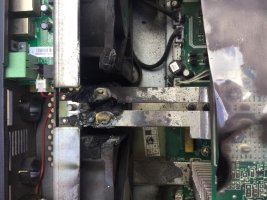Bigfillly
Member
- Joined
- Aug 20, 2017
- Messages
- 126
Hi,
This morning I was working on my car at the front of the house, I went round the back to the shed for a spanner and noticed a smell, I thought it was someone having a fire, it was only when I got near the battery shed I saw smoke and the fan on the inverter was making a right noise, I ran to it and turned everything off just as I saw a flame, if I was on the front for another 20 seconds it would be a different story,
This is what I found on my pip50/48hs inverter
For a guess the PV input burnt through and shorted out on each other

This morning I was working on my car at the front of the house, I went round the back to the shed for a spanner and noticed a smell, I thought it was someone having a fire, it was only when I got near the battery shed I saw smoke and the fan on the inverter was making a right noise, I ran to it and turned everything off just as I saw a flame, if I was on the front for another 20 seconds it would be a different story,
This is what I found on my pip50/48hs inverter
For a guess the PV input burnt through and shorted out on each other






